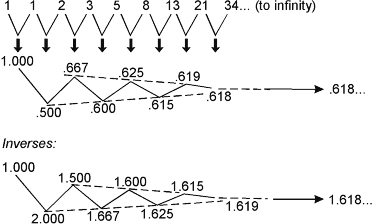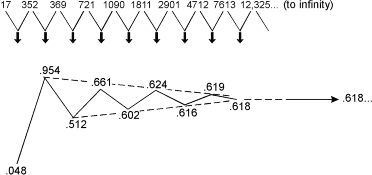As we will show in
subsequent lessons, the spiral-like form of market action is
repeatedly shown to be governed by the Golden Ratio, and even
Fibonacci numbers appear in market statistics more often than mere
chance would allow. However, it is crucial to understand that while
the numbers themselves do have theoretic weight in the grand concept
of the Wave Principle, it is the ratio that is the
fundamental key to growth patterns of this type. Although it is
rarely pointed out in the
literature, the Fibonacci ratio results from this type of additive
sequence no matter what two numbers start the sequence. The
Fibonacci sequence is the basic additive sequence of its type since
it begins with the number "1" (see Figure 3-17), which is the
starting point of mathematical growth. However, we may also take any
two randomly selected numbers, such as 17 and 352, and add
them to produce a third, continuing in that manner to produce
additional numbers. As this sequence progresses, the ratio between
adjacent terms in the sequence always approaches the limit phi
very quickly. This relationship becomes obvious by the time the
eighth term is produced (see Figure 3-18). Thus, while the specific
numbers making up the Fibonacci sequence reflect the ideal
progression of waves in markets, the Fibonacci ratio is a
fundamental law of geometric progression in which two preceding
units are summed to create the next. That is why this ratio governs
so many relationships in data series relating to natural phenomena
of growth and decay, expansion and contraction, and advancement and
retreat.

Figure 3-17

Figure 3-18
In its broadest sense, the Elliott
Wave Principle proposes that the same law that shapes living
creatures and galaxies is inherent in the spirit and activities of
men en masse. The Elliott Wave Principle shows up clearly in
the market because the stock market is the finest reflector of mass
psychology in the world. It is a nearly perfect recording of man's
social psychological states and trends, which produce the
fluctuating valuation of his own productive enterprise, making
manifest its very real patterns of progress and regress. What the
Wave Principle says is that mankind's progress (of which the stock
market is a popularly determined valuation) does not occur in a
straight line, does not occur randomly, and does not occur
cyclically. Rather, progress takes shape in a "three steps forward,
two steps back" fashion, a form that nature prefers. In our opinion,
the parallels between and Wave Principle and other natural phenomena
are too great to be dismissed as just so much nonsense. On the
balance of probabilities, we have come to the conclusion that there
is a principle, everywhere present, giving shape to social affairs,
and that Einstein knew what he was talking about when he said, "God
does not play dice with the universe." The stock market is no
exception, as mass behavior is undeniably linked to a law that can
be studied and defined. The briefest way to express this principle
is a simple mathematical statement: the 1.618 ratio.
The Desiderata, by poet Max
Ehrmann, reads, "You are a child of the Universe, no less than the
trees and the stars; you have a right to be here. And whether or not
it is clear to you, no doubt the Universe is unfolding as it
should." Order in life? Yes. Order in the stock market? Apparently.<% end if %>
|